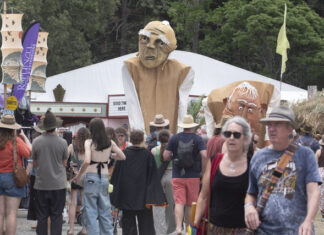Journalist, author and top surf historian Phil Jarratt has come a long way since he was a Daily Telegraph copy boy in the late 60s, living for his weekends and the chance to crack waves on Sydney beaches.
Phil is 62 now but his love of the surf hasn’t diminished. Indeed, when he spoke with Noosa Today about his new book “That Summer at Boomerang” – the story of Hawaiian board rider Duke Kahanamoku, the father of modern surfing – he had just spent two hours on the waves and intended going home to get on with planning Noosa’s Festival of Surf in March.
Surfing and writing about it has dominated most of his life. While still at school, he was writing for US and Australian surfing magazines. “I was a published writer and I thought I was pretty smart so there was only one career trajectory for me to take – to become a journo.”
In the early 70s he worked for the Sydney Morning Herald in the Canberra Press Gallery (“a fantastic thing to happen at such a young age”) and did the Aussie journalists’ pilgrimage of the time to London and Fleet Street.
“I worked as a casual features writer on the Daily Mail and magazines to subsidise my travel. I followed the surf up and down the coasts of Spain, France, Portugal and most of England.”
Two years later he was back in Australia, working full-time with surf publications, becoming editor of the big circulation youth magazine Tracks, then stints with Channel 9, Playboy, Penthouse and in a turnaround culture change, The Bulletin.
It was working for The Bulletin which brought Phil and his family to Noosa in 1990. “The editor was looking for a Queensland correspondent and I put my hand up. I had known about Noosa before so it wasn’t hard to decide to come here instead of working from Brisbane. In 1996 I helped start a local magazine, Noosa Blue. It had a very successful run for a few years, tapping into every level of Noosa society, the environment, restaurant reviews.”
Five years in France with the family followed to work for international surf company, Quiksilver and then back to Noosa in 2008 where he now writes a weekly column for this newspaper. With his daughter, Sam Smith, he also runs the Noosa Festival of Surfing – considered the biggest surfing event of its kind in the world.
“It has developed a huge reputation as a showcase for Noosa’s natural attributes and, as such, we’ve attracted really good support from tourism authorities and by Government which is great,” he said.
Phil “always has a book on the boil.” He has written 35 in all, including biographies on Evonne Goolagong Cawley and Clean-Up Australia creator, Ian Kiernan. It’s for his surfing non-fiction, however, about legends like eight times world champion, Kelly Slater, and Jeff Hakman, as well his complete history of Australian surfing, Surfing Australia, that has earned him the reputation of Australia’s leading surf historian.
Phil says it was the research on these projects that led him to the story of Duke Kahanamoku and his ground-breaking tour of Australia and New Zealand in 1914-15 which he considers was really the start of beach culture in this country, changing forever perceptions of surfing and swimming.
“The term I use in the book is that it was ‘the birth of fun.’” With Federation there was a whole new feeling of what was possible. In 1902, daylight saving was legalised which opened the way for people to actually use the beach as God intended it, which is to go surfing. The surf lifesaving movement started a couple of years later and, suddenly, the beach was a playground and you could get there by automobile. All those things were in play.
“And you have the backdrop of the Great War which was just beginning. People the Duke was associated with in that summer of 1914-15 included Cecil Healy the guy he beat for the gold medal at the Stockholm Olympics in 1912. He wouldn’t have come here if he hadn’t been mates with Healy.
“Duke failed to show up for his 100 metres semi-final and Healy said he wouldn’t swim in the final unless the world’s fastest swimmer was given the opportunity to qualify so they ran a special qualifier and Duke got through, of course. He won the gold medal and Cecil missed out. Cecil invited Duke to come to Australia to demonstrate his swimming and surfing skills.”
Healy was killed in the Battle of the Somme in 1918 and says Phil, “This is the backdrop of the book. Australians had discovered leisure and now they had to go and die in Europe.”
He also explores the relationship between 15-year-old Manly schoolgirl, Isabel Letham, another iconic figure in the world of surfing, and the Duke. “While nothing happened between them that we know of, I don’t think there is any doubt that meeting him changed the course of her life. Before the war was over she was on her way to America looking for him. She did meet up with him in the 20s when he was a B grade Hollywood film star. He didn’t get married until he was 50 and she never married.”






